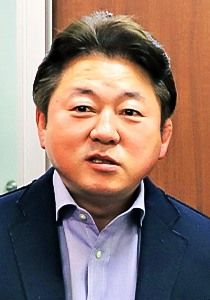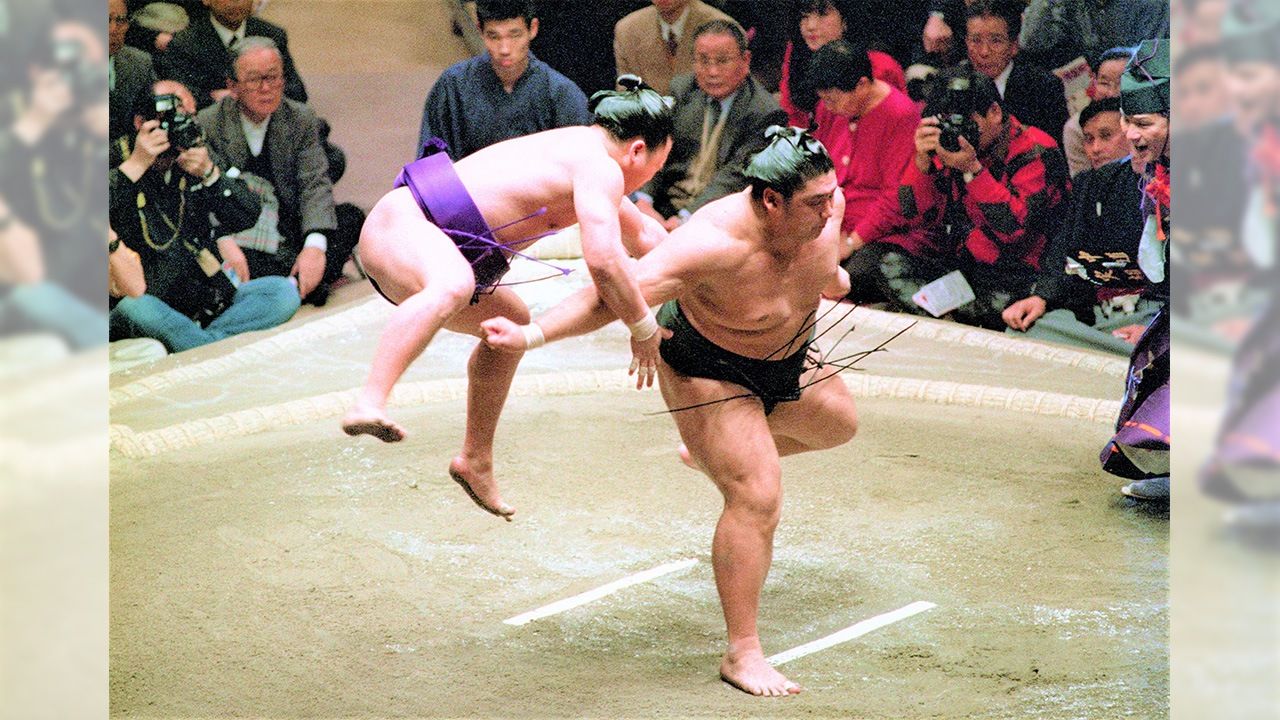
The Essence of Mainoumi’s Sumō: When Small Can Win Big
Culture Sports- English
- 日本語
- 简体字
- 繁體字
- Français
- Español
- العربية
- Русский
Standing Firm to Win
INTERVIEWER You used mitokoro-zeme, the triple-attack force-out, for the first time at the November 1991 tournament in your match against Akebono, upending him spectacularly. This rare kimarite winning move hadn’t been used in top-level sumō since the 1950s, when jūryō division fighter Nachinoyama won four matches with it. Did you have that move up your sleeve because you were matched against him for the first time?
MAINOUMI SHŪHEI No. I had used mitokoro-zeme from time to time during my college fighting days, and although I didn’t have it in mind specifically, that’s just the way the bout went. When you’re small, you can burrow your head into your opponent’s chest, and if you pin down his legs, he won’t be able to move. It’s as if his feet are glued to the spot, so he can’t step back when pushed and all he can do is fall over. [Laughs] That’s how the move works.
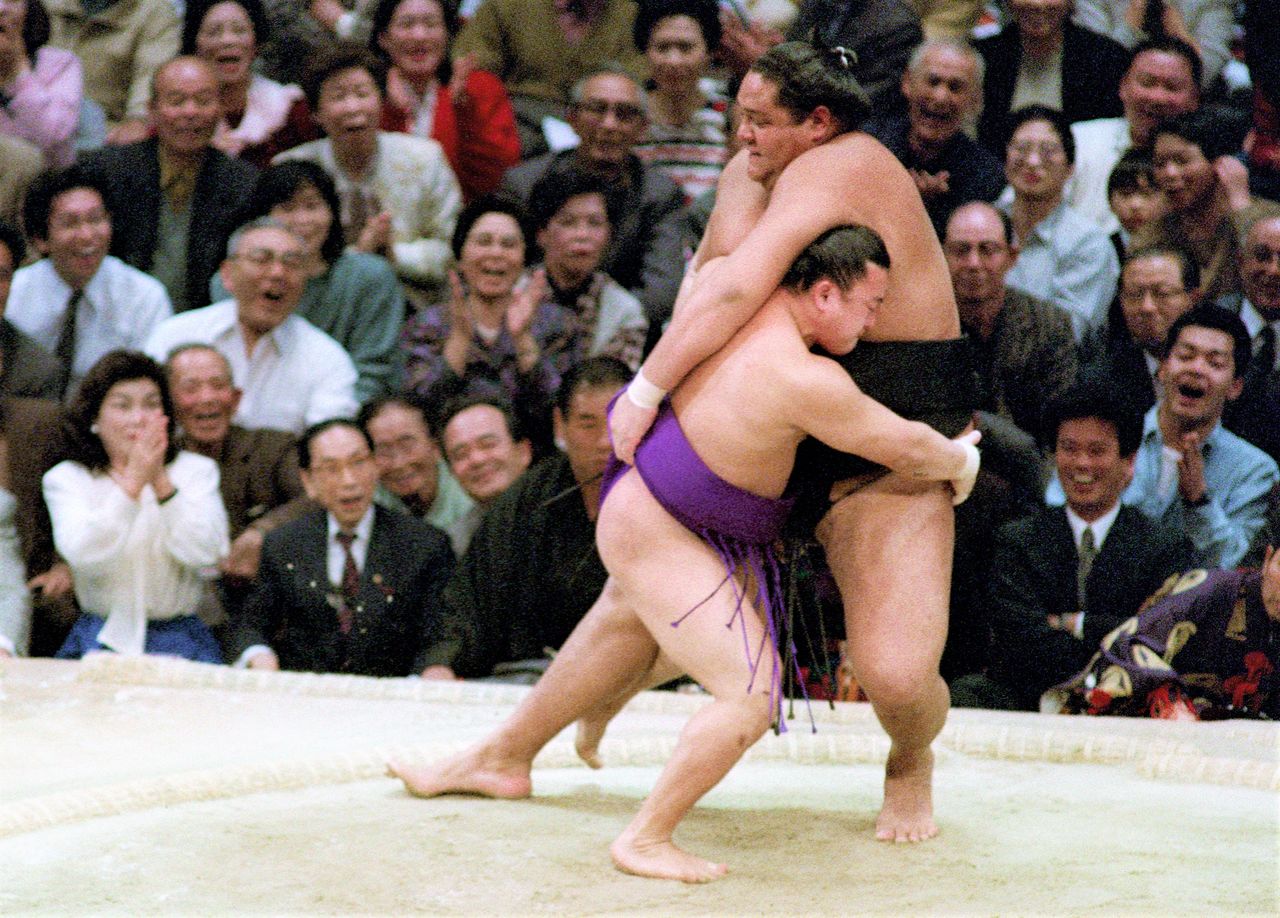
Mainoumi executes mitokoro-zeme against Akebono on November 20, 1991, at the Fukuoka Kokusai Center. (© Jiji)
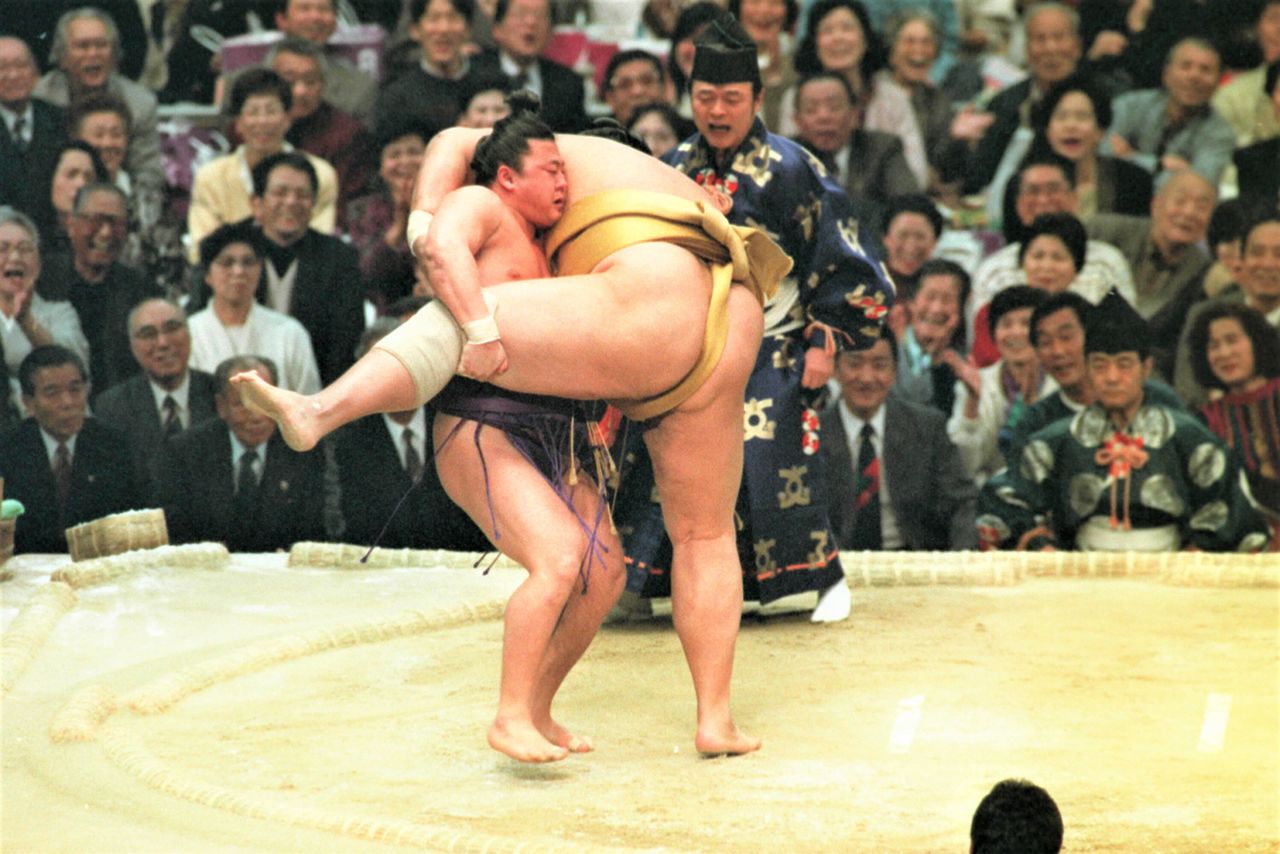
In this 1993 match against Mitoizumi, Mainoumi (at left) used his low center of gravity effectively to grab a leg and down his much larger opponent. “In sumō, the key to winning is getting your opponent off-balance.” Taken on March 17, 1993, at the Osaka Prefectural Gymnasium. (© Jiji)
Trump Card Downs Takanohana
INTERVIEWER You excelled at the left-handed shitatenage underarm throw, grasping your opponent’s mawashi belt deep from the left and then using kirikaeshi as the trump card.You felled top wrestlers one after the other with kirikaeshi, putting your knee behind the opponent’s knee to trip him backward. One particularly memorable occasion was the July 1994 tournament, when you grappled with Musōyama on the fifth day. He came up behind you at the edge of the ring, but you twisted and turned and used kirikaeshi to topple him—although the official kimarite was called as sotogake, or outside leg trip.
MAINOUMI In my student days, when I was trying to fend off my opponent’s throw, my knee would end up pinned by his foot. But when I entered the professional ranks, Takasaki oyakata taught me that when using kirikaeshi, I should fall back myself. Thanks to that tip I became able to consciously execute the move.
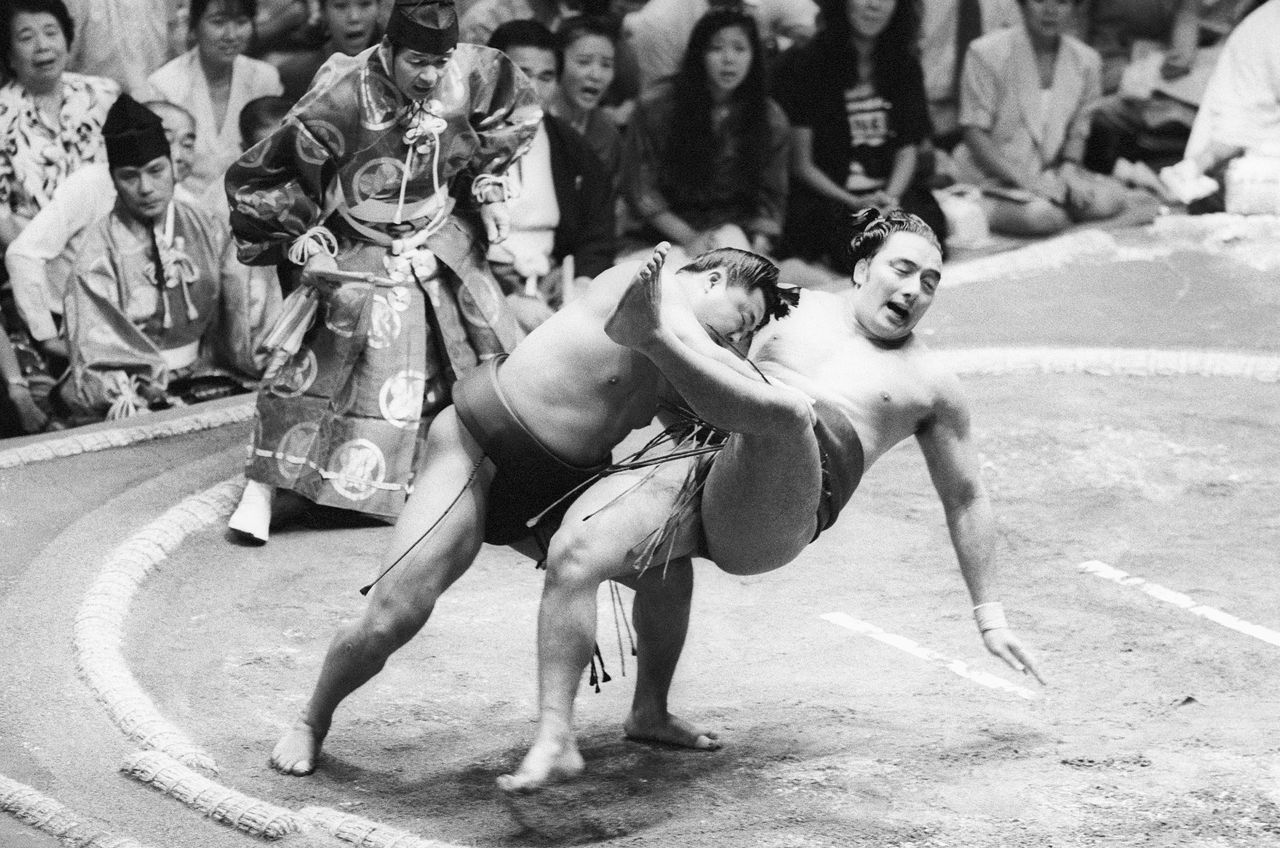
Mainoumi and Terao, two popular and comparatively light rikishi, grapple at the 1991 September basho. Mainoumi won the match with a cleanly executed kirikaeshi. Taken on September 10, 1991, at Ryōgoku Kokugikan. (© Jiji)
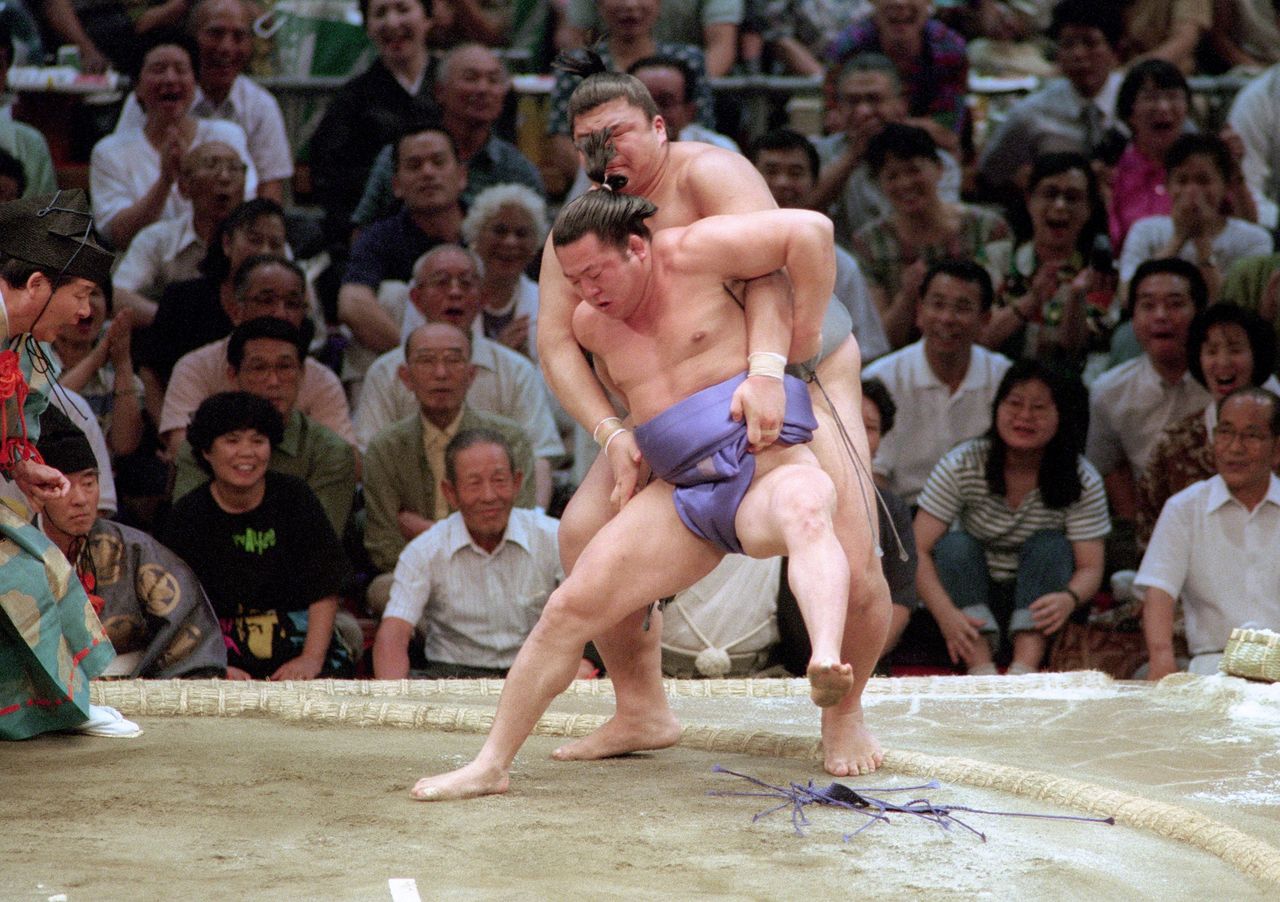
At the July 1994 basho, Mainoumi was at a disadvantage, with Musōyama behind him, but Mainoumi recovered and won the match. Taken on July 7, 1994, at the Aichi Prefectural Gymnasium. (© Jiji)
INTERVIEWER You executed kirikaeshi brilliantly against Takanohana on the second day of that tournament, too. Takanohana was still an ōzeki at the time, and although he had missed out on being promoted to yokozuna, he was a yokozuna-caliber fighter.
MAINOUMI Well, that’s was the only time I won against Takanohana! [Laughs] If you try to execute kirikaeshi while standing, you can only exert force through your hands and your knees, meaning that you’ll fall if you lift your opponent. You’ll lose the match that way, so the trick is to twist your opponent down as you fall.
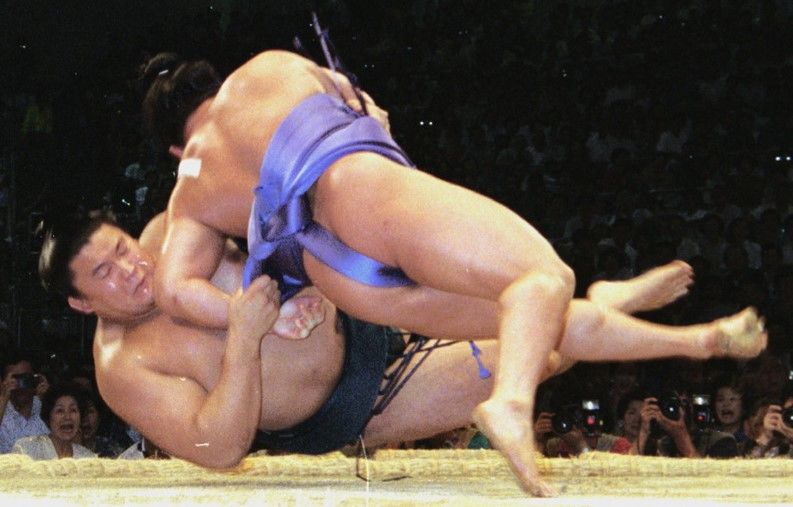
Mainoumi racked up his first win against Takanohana, forcing him down using kirikaeshi while falling himself, on July 4, 1994, at the Aichi Prefectural Gymnasium. (© Kyōdō)
INTERVIEWER The high-rankers in those days were really talented, and spectators greatly enjoyed their matches. You were really spectacular at that tournament too. I think you were at the peak of your ability, but at the September tournament, just when you had been promoted to komusubi rank, you severed a tendon in your left arm in your match against Takatōriki.
MAINOUMI Yes, that was the beginning of the end. [Laughs]
Using Dizziness and the Element of Surprise
INTERVIEWER You say “the end,” but you continued to use a range of techniques to great effect, your totally unexpected moves stirring great excitement among spectators. Your left-handed under-the-belt grip was your mainstay move, so your left arm injury was catastrophic. But you compensated by, for example, going for a right-handed over-the-belt grip and literally running rings around your opponents. You kept pulling at them, making them turn and getting them dizzy, and once they were off-balance, using oshidashi frontal push-outs or yorikiri frontal force-outs to bring them down. I don’t think I’d ever seen anyone going round and round like you did in the ring. I watched you the first time you did that on television, so I suppose you practiced the technique beforehand, maybe at your university sumō club?
MAINOUMI That’s right. I practiced with Ono Tsukasa, a fellow club member, who asked why I didn’t keep going if I didn’t defeat my opponent with a throw the first time around, and who urged me to keep going at him.
INTERVIEWER You mastered 33 of the 82 officially approved kimarite, while also devising a whole repertoire of unorthodox techniques. Let’s start with nekodamashi, the “cat-startling” hand-clap in the opponent’s face at the tachiai faceoff that inevitably caused him to blink. It’s not such a formidable move in itself, so was it just meant to intimidate the opponent? What was the effect of the move?
MAINOUMI I had two aims. One was to stop the other man from coming at me, and the other was, by crouching after stretching my arms out to clap, to give me space to get in low for the grapple. I couldn’t do that if the other man was too close, and if there was too much space between us, he could see me closing in. Arm’s length was just the right distance for going into a crouch and aiming at the opponent’s lower back.
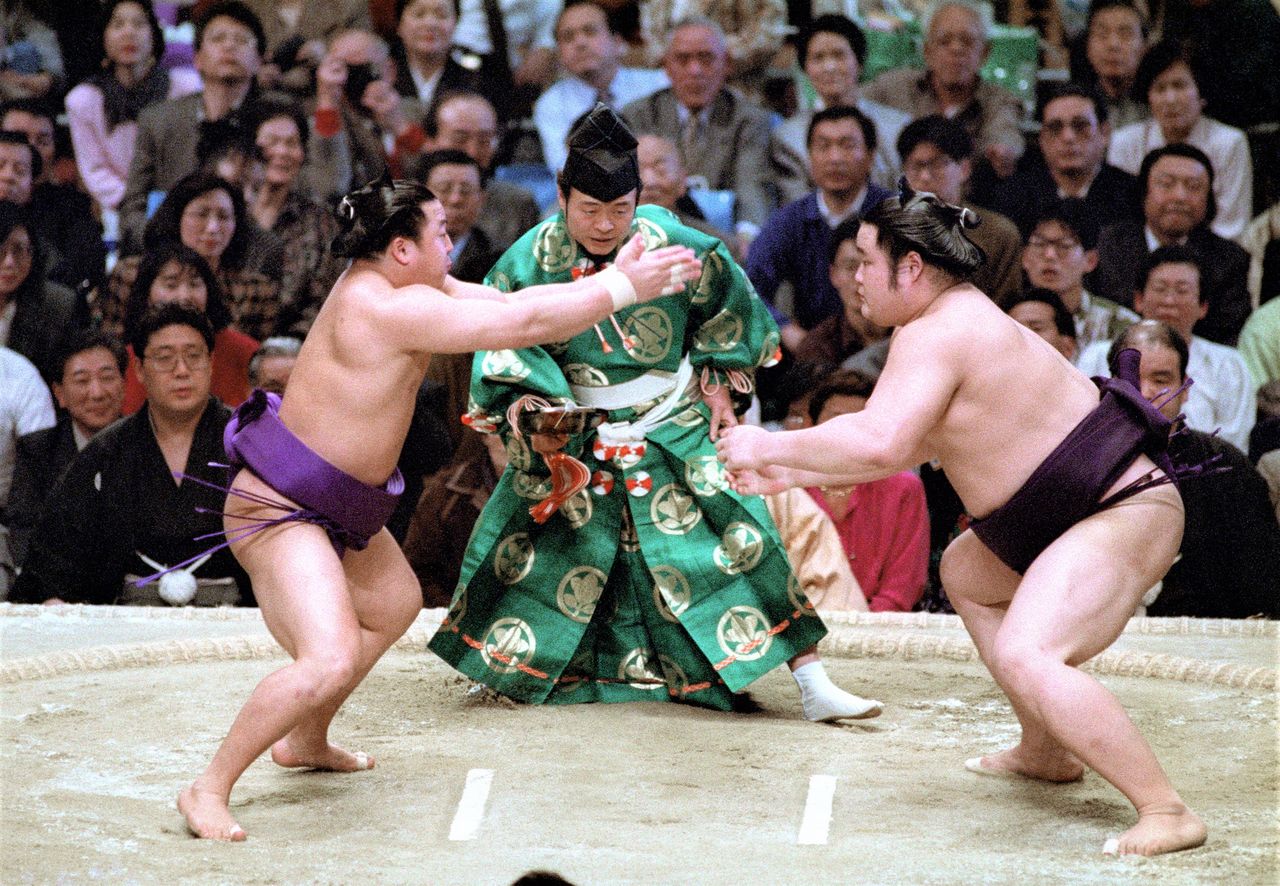
Mainoumi uses nekodamashi to throw Tomoefuji off his stride at the tachiai at the March 1992 basho. Taken on March 20, 1992, at the Osaka Prefectural Gymnasium. (© Jiji)
INTERVIEWER There was also your hassōtobi, the “eight-boat leap,” a sidestep jump at the tachiai that allowed you to slip behind the opponent. Many rikishi vary their tachiai moves, but I don’t think anyone had ever seen a start with such a high jump before. It was retired yokozuna Wakanohana I [1928–2010], who as Futagoyama oyakata chaired the Japan Sumō Association, who gave the move its name, saying that it brought to mind Minamoto no Yoshitsune’s legendary leap to a vessel “eight boat-lengths away” at the Battle of Dannoura to escape a foe.
MAINOUMI Actually, hassōtobi also came about at the suggestion of Ono, the man who had encouraged me to keep my opponents in a tizzy. He said that just about all I ever did was go down low, so he thought I should work hard to vary my moves. When I asked how, he said I should jump so high as to almost go over my opponent’s head. Well, I didn’t think that was feasible, but when I tried it with makushita lower-ranking sparring partners in the practice ring, I found it really easy to pull off.
INTERVIEWER Ono had quite a bag of tricks, didn’t he?
MAINOUMI For sure. When you’re trying to think of something new by yourself, you tend to run out of ideas, so his input was really helpful.
Upending a Sumō Truism
INTERVIEWER All I can say is that you have been the most imaginative rikishi when it comes to tachiai. In your first bout with Akebono, there you were, stretching upward as Akebono came at you ready to grab your belt with both hands, when you quickly feinted and burrowed into his chest. What marvelous split-second timing that was! And when you faced off with Kyokudōzan, you stepped back, when normally your opponent would have expected you to advance. No one had ever done anything like that before.
MAINOUMI I took the opposite tack to what every other rikishi thought. Everybody was focused on the tachiai, but I thought, “What about skipping over the tachiai and starting from the next step?” I knew I would get pushed over right away in a head-on attack, so I was thinking “How can I move before my opponent lunges at me, or how can I deflect his momentum?” It’s enough to just dial down the strength of his charge from a ten to a seven.
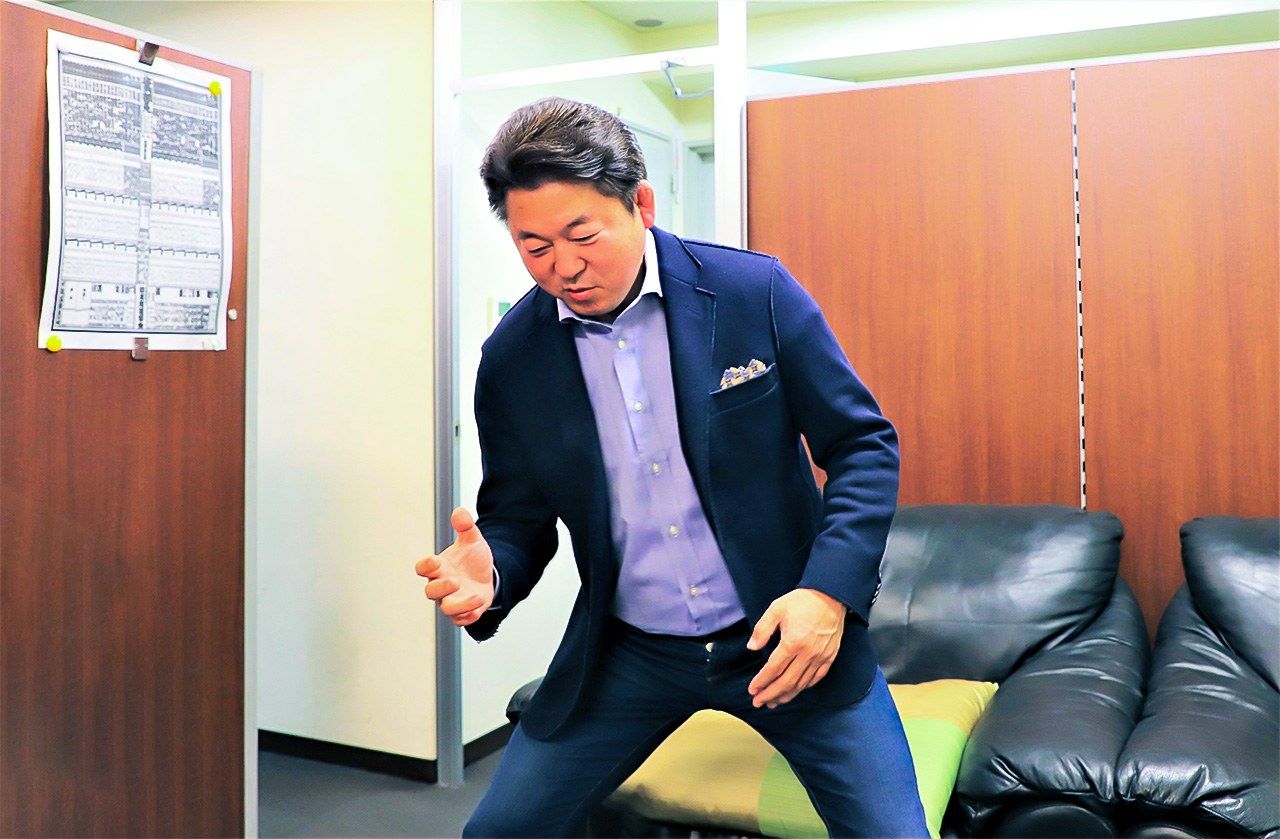
During the interview, Mainoumi frequently stood and gesticulated to demonstrate a move. His commentary during NHK sumō tournament broadcasts is clear and easy to follow. (© Nippon.com)
INTERVIEWER Oyakata acting as commentators during television broadcasts often say “It all came down to the tachiai in that match,” a sign that they believe the tachiai is the be-all and end-all. You’ve noted that this mistaken opinion has become a truism over time, but showed in your own wrestling that a rikishi with a poor faceoff can often win by repositioning himself.
During your career, you upended the givens of sumō and displayed truly original prowess that left fans in awe. Let’s talk a bit more about that aspect of your sumō when we continue.
MAINOUMI Yes, let’s!
(To be continued.)
(Originally published in Japanese. Banner photo: Recalling the first time he used the hassōtobi sidestep move in his bout against Kitakachidoki at the 1992 January basho, Mainoumi says, “I was trying to get around behind him, but at the faceoff I jumped a bit too far to the left and when I landed, I almost ended up with my hand touching the ring.” Taken on January 18, 1992, at Tokyo’s Ryōgoku Kokugikan. © Jiji.)
